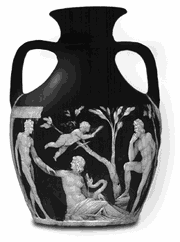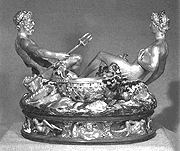| back to: Chapter 10

Portland Vase
Rome
glass
c. 3rd C. BCE (Late Roman)

Icicle Creek Chandelier
Dale Chihuly
glass
1996 (Postmodern)

Salt Cellar for Francis I
Benvenuto Cellini
metalwork
1539-1543 (Mannerist)
|
Chapter 11: Craft and Design
Ceramics
- METHODS OF WORKING WITH CLAY
pinching, modeling, patting, rolling, coiling, and throwing on a potter's wheel are all ways to work with clay.
- THE POTTER'S WHEEL
was invented around 4000 BCE in the Middle East and it allows an artist to create symmetrical round forms.
- GLAZING
not to be confused with the glazing technique used in painting, glazing is the process of adding a coating to the fired ceramic object. In this process the piece is bisque fired then a slip mixture is applied to the surface and fired again. The surface becomes vitrified (non-porous) making it useful for holding liquids.
- TYPES OF CERAMICS
- earthenware is usually a red, soft clay that is somewhat brittle and fires at a low temperature (@ 2000-2300 F). Terra cotta is an example of an earthenware.
- stoneware is a stronger clay body that is fired at higher temperatures (@ 2300-2700 F). It is often used in pottery and sculptures.
- porcelain is very hard, non-porous, and semi-opaque. It also fires at a high temperature (@ 2400-2500 F). Fine dinnerware and some sculpture are made from porcelain.
Glass
- TECHNIQUES OF WORKING WITH GLASS
Glass is most often used in a molten form and worked using high heat. The molten galss is flexible enough that a trained craftsman can "blow" the glass to create a bulbous or spherical form.
- EXAMPLES OF GLASSWARE
flint-glass is an ancient process of creating glass. The Portland Vase is a late Roman piece that uses this process. Cut glass and blown glass are also two processes used by glass artists. Dale Chihuly's Icicle Creek Chandelier is a blown glass piece that was constructed by a team of glass blowers in his Seattle studio.
Fiber Arts
- WEAVING
The textile art of weaving is accomplished by using intertwining threads (warp and weft) usually by using a loom.
- QUILTS
are tradtionally sewn blankets that are made of pieced fabric. Faith Ringgold is a contemporary artist who uses the idea of the quilt to better communicate stories from her childhood as in Tar Beach.
- BASKETRY
is a type of weaving traditionally using natural grasses, bark, or wood.
Metalwork and Jewelry
- Metalworking materials like brass, silver, and gold are often used in metal-fabricated objects. Benvenuto Cellini's Salt Cellar from the 16th Century is an example of metalwork using gold as the main medium.
Wood
- Processes for fashioning objects from wood include carving, burning, and turning the piece. Turning usually involves the use of lathe, or a tool which spins the wood while the artists carves away the surface with a chisel.
Design
- GRAPHIC DESIGN
is the process of creating communicative artwork for print purposes. The use of logos and typography (the study of type) is integral to graphic design
- package design is the creation of 3-D design objects for packaging purposes.
- posters are large printed graphics usually created using offset printing methods.
- logos are a visual identity that a designer creates to identify a company, brand or idea.
- INDUSTRIAL DESIGN
is the creation of physical products for the marketplace. Artists of the Bauhaus set standards for industrial design that still endure.
- WEB DESIGN
are designs that are interactive and allow a viewer to access information via the World Wide Web. The UE Art Department Web Site is a good example of web design in action.
- URBAN DESIGN
was practiced by the early Babylonians and the Incas. It is the process of designing the layout of urban areas for more organized living. One excellent example of Urban planning is the design of Washington, D.C. by Pierre-Charles L'Enfant
Chapter 12
| |
|
